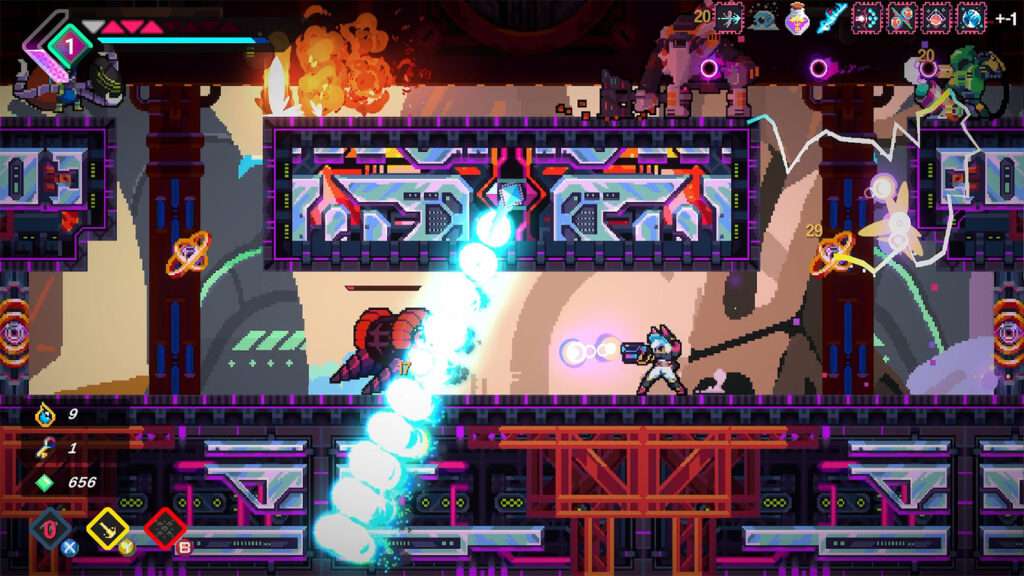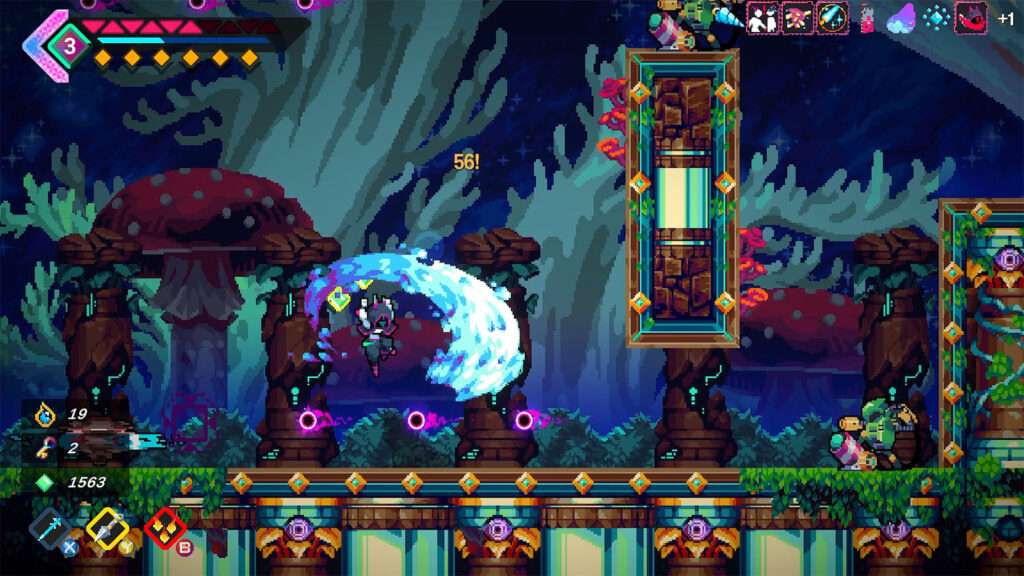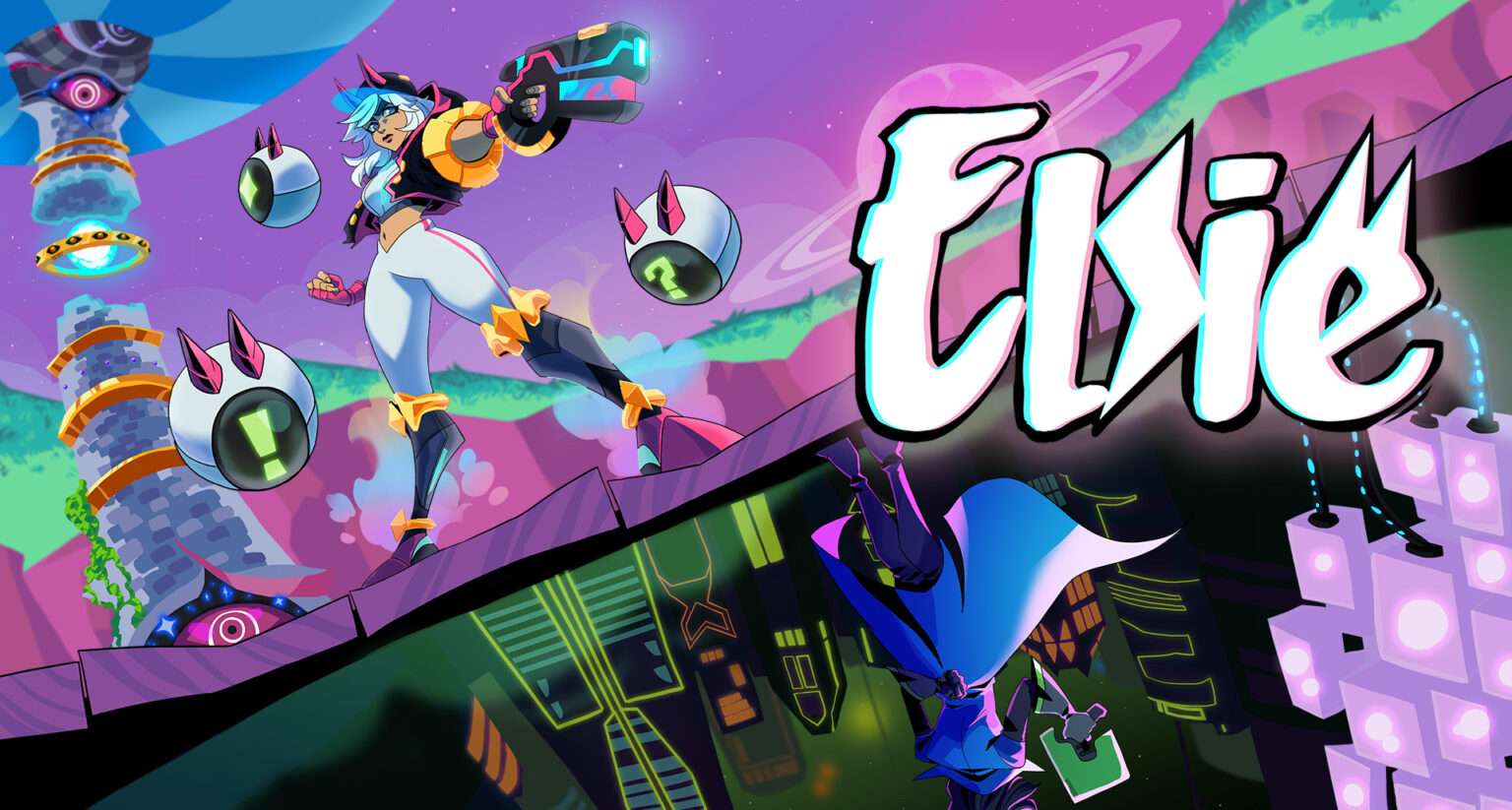This Elsie review is played and tested on Nintendo Switch. The game is also available for Steam and Playstation 4/5 for €/$ 19,99.
The first thing that passed through my mind when the key for Elsie arrived in my mailbox was that I wasn’t up for yet another roguelike. Again… The genre has had a good run but has been sucked dry of anything mesmerizing by now. I personally had a lot of fun with AK-Xolotl (which was reviewed by Rob), Dead Cells, and in the past Hades kept me busy for a while. But somehow, the genre has a tendency to wear me out quite fast. I also started to think that maybe roguelike players are a unique breed, of which I’m not a pedigree.
Androids gone wild
Elsie is a fast-paced roguelike platformer developed by Knight Shift Games. The protagonist, Elsie, wakes up in a dystopian world. In an attempt to turn the tide on an unavoidable disaster, Dr. Grey developed a bunch of androids to protect her home planet, Ekis. But against all odds, the androids turned against their creator and unleashed hordes of robots on the planet. Elsie is Dr. Grey’s last hope to defeat the rogue androids and restore Ekis to normal.
The game is a true roguelike, where you fight through procedurally generated levels, die a lot, and use found currency to unlock new weapons and features after each run. You can select one of the unlocked weapons before each run. Everything else resets for the next run, resulting in a unique character build each time. If you get far enough, you’ll encounter boss battles. Elsie conforms willingly to the formula, mixing the roguelite experience with Mega Man X-style platforming.

Weapons and Upgrades
To survive the hordes of enemies, Dr. Grey and her weapons smith equip you with a wide range of weaponry, each with its own unique characteristics. Shotguns, three-way shots, rocket launchers, and more become available as you progress. Along the way, you’ll discover numerous upgrades for your weapons, with creative twists like bullets that remain idle at the end of their range or ones that bounce off walls. These upgrades can combine with most weapons, offering plenty of customization. You also have a special attack, dash, and parry at your disposal, all of which can be upgraded too in some ways. However, the sheer number of options can sometimes feel overwhelming, and once you’ve picked up a few upgraSometimes, you might feel ridiculously overpowered—defeating bosses in just a few hits. Other times, if the upgrade choices don’t favor you, you’ll find yourself scrambling with underwhelming options.The experience feels uneven, with some runs making you feel invincible while others leave you struggling.
The amount of weapons tend to feel a bit overkill, I’d rather stick to my 3-way shot or shotgun as alternative to the default pea-popper. Most other weapons are either clumsy and do not fit the fast paced platforming. This requires re-strategizing your attack plan as it significantly changes the way the game is played. This might be music to the ears of roguelike aficionados, but even the hardcore audience rather stick to the guns the game offers up early on.

Parrying
The parry move is probably the most interesting mechanic of the bunch. It’s kind of finicky to execute but allows you to parry an attack or a bullet, which opens up the enemy for a counter. I constantly messing up the parries early on. But again, practice makes perfect, and eventually, it clicked enough for me to use it beyond just the necessary applications, like enemies with shields.
Confusement
Some games succeed better than others in conveying what they want you. Unfortunately Elsie is not a shining example of clarity in that respect, in my opinion. Understanding and automating the mechanics is more challenging than it should be.
Another gripe is that the text is so tiny on the Switch. On my OLED screen in handheld mode that I have to squint just to read it. The way the text animates doesn’t help readability either. To make matters worse, the text occasionally doesn’t even fit within the dialogue boxes or the screen.

There is a text scaling option in the options menu, which scales the text but in very small amounts. Enough though, to derail the textboxes that run out of real estate to harbour the bigger font.
Options menu shenanigans
As expected, you ‘manage’ your build through the inventory menu. This is yet another area where the developer struggles with UI design. The game fails to clearly indicate what is interactable on screen and what is not. While it suggests you can change your build here, you actually can’t. You can only change two buffs, and there’s no confirmation of the actions you take in the menu at all. It’s a bit of a mess.
OK, I know I’ve spent a lot of time griping about the UI, but in my defense, it completely took me out of the game for the first few hours. I still have problems with button assignments where interaction is either A or the right trigger, constantly wasting energy. Both literally and figuratively, as the A button restores energy. Every time I want to open a chest, I end up using an energy token by pressing the wrong button. The game is just not programmed the way I am after 40 years of gaming experience.
Accessibility features
On the other hand, Knight Shift Games went out of their way to make the game accessible for the visually impaired, adding colorblind palettes and an option to turn off background imagery for a quieter, less distracting gaming experience.
Roguelike at all costs
That said, none of this takes away from what the game truly excels at: delivering fast-paced platforming action. Elsie’s overall jump and wall-hopping mechanics are responsive and fun to play with. The ever-changing arsenal encourages experimentation with different approaches to deactivate your android enemies. Each world you encounter offers a new set of enemies, or enhanced versions of enemies you’ve already encountered, encouraging you to adapt your gameplan.
Basically, every new world reboots your knowledge, keeping the gameplay fresh. After defeating a boss, the game randomly sends you to a new world. It’s a fun little twist as it lets you become familiar with multiple worlds simultaneously, rather than one after the other.
I wish Elsie—with all its platforming and shoot ’em up glory—would be fine without the roguelike element. As a roguelike, it doesn’t achieve anything so special that a regular platformer with limited roguelite elements couldn’t have accomplished. Drip-feeding a not-so-interesting story between runs only highlights Elsie’s mediocrity in that regard. Getting up to speed every run makes the game sluggish than it needs to be. However, when you’re deep into a run, decked out with upgrades, Elsie is reaching it’s full potential and a lot of fun.
Check other Retrolike Nintendo Switch reviews on our Switch review page.
Roguelike diehards will feel right at home in the cyberpunk world of Elsie, but gamers seeking a straightforward platforming experience might find the roguelike mechanics unnecessary. The biggest gripe that Elsie is conforming too much too the genre. When you have the right upgrades at your disposal and the action is firing on all cylinders, Elsie is hard to put down. However, it feels like a chore to reach that point within every new run.
The good
- Solid high speed Megaman X-sque platformer
- Pixel art as well as cutscene art are great
- Tons of guns, buffs and upgrades
The bad
- Messy UI and font issues
- Just another roguelike which takes it time to get going


